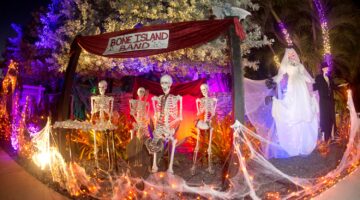A Deathbed Declaration By Founder Of Alpha 66
By Mark Howell
It was just days before the seminar on the Kennedy assassination held by Shirrel Rhoades and Tim Gratz that drew 110 attendees to the Tennessee Williams theater earlier this month that the stunning news arrived about the death of Antonio Veciana
He was the leader of Alpha 66, ta Cuban exile organization committed to overthrowing Cuban Prime Minister Fidel Castro.
Veciana’s death in fact occurred two months ago, just days after he had authorized a person named Marie Fonzi to release a dramatic statement identifying a character called “Maurice Bishop” as being in fact David Atlee Phillips, a longtime dirty-tricks operative for the CIA, a man widely suspected of having played a role in a plot to assassinate President Kennedy.
Marie is the widow of Gaeton Fonzi, a writer and researcher well known to Key West locals Rhoades, Gratz and to Howelings too, all of us collaborators on a recent book from local publisher Absolutely Amazing Books called “The Men at Sylvia’s Door.”
It was Fonzi (who died in 2012) that first provided us with clues that Lee Harvey Oswald and Jack Ruby may have been seen together at Key West Airport before the assassination. In addition to his writings, Fonzi, had also been an investigator for the Church Committee and the House Select Committee on Assassinations.
The deathbed declaration by the dying Veciana, insists Marie Fonzi, should now “lead the American people to demand the immediate release of the thousands of pages of JFK assassination-related records that the CIA is still withholding, and demand that Congress hold oversight hearings into the CIA’s subversion of the investigation conducted by the House committee that conducted the last official investigation of the assassination.”
Marie tells us that in the days leading up to last year’s 50th anniversary of the assassination of President Kennedy, G. Robert Blakey, the chief counsel and staff director to the 1977 House Select Committee on Assassinations, worked hard to discredit her late husband’s book. In “The Last Investigation,” Fonzi meticulously detailed the many conspiracies and various motivations that led to that fateful day in Dallas.
“It is important to track the history that has led to this misguided effort by Blakey,” explains Gaeton’s widow, Marie.
As everyone knows, a week after the assassination, Lyndon B. Johnson appointed a commission headed by Supreme Court Justice Earl Warren to look into the murder of the president. One of this committee’s members was Allen W. Dulles, a former director of the CIA. In September 1964, the Warren Commission issued its report, concluding that Lee Harvey Oswald was the lone shooter and that there existed no conspiracy.
“This conclusion was reached erroneously,” declares Marie. “Dulles had consistently hid from the commission the many CIA-sponsored plots to kill Cuba’s Fidel Castro.” These omissions, she claims, “were not an oversight.” In her view, it proved convenient for Dulles to hide the fact that the CIA had used the services of Mafia dons John Roselli and Sam Giancana in its attempts to assassinate Castro. Dulles also concealed that CIA operative Maurice Bishop employed Antonio Veciana in October 1961 in another plot to kill the Cuban leader.
“Had the Warren Commission been alerted to these activities,” points out Marie, “its investigators would have looked more closely at the CIA’s dealings with the Mafia.” Most importantly, if the connection between Bishop and Veciana had been probed, this, fact too would have yielded the information that Bishop, a CIA field officer, was linked to Oswald.”
Apparently the late Veciana had actually seen Oswald together with Bishop days before the assassination.
And yet, continues Marie, “the CIA consistently and thoroughly opposed any efforts by investigators to uncover the truth, not only during the Warren Commission’s investigations but also in the later years when the House Select Committee on Assassinations looked into Kennedy’s murder.”
A close examination of Blakey’s behavior as the last head of the House Select Committee, concludes Marie, “raises many questions about his impartiality.” Blakey refused to take important testimony from key witnesses, using deadlines as an excuse to say the investigation had finished.” This was upsetting to many of the committee’s investigators, including her husband Gaeton “who’d worked so diligently to expose the facts.”
Blakey, she reveals, asked Richard Billings, a former editor of Life magazine, to write the final report. But Billings “had not participated in any part of the investigation and was forced to limit himself to what Blakey instructed him to write.”
Marie now believes that Blakey’s motivation in obfuscating the facts was because he was his was angling for a senior appointment within the CIA.
All Howelings now knows for sure is that this long-standing feud has reached a new extreme with Veciana’s deathbed declaration that Gaeton Fonzi had been right all along and Blakey chose to ignore it.
Meanwhile, another tidbit: The passing of Veciana has stirred up our personal memories of that mysterious man who entered the modern history of the Florida Keys with his activities involving Alphaa 66 and its campaigns against the Castro regime from right here in the Florida Keys
Gordon Winslow, winner of a New Frontier Award as a leading assassination researcher in South Florida, who happens to be a longstanding pal of Rhoades, Gratz and Howell, tells a story tthat Veciana once confessed to him about where the name of Alpha 666 came from.
“He was driving past a Phillip’s 66 gas station and that was it.”
Simple is as simple does.
[livemarket market_name="KONK Life LiveMarket" limit=3 category=“” show_signup=0 show_more=0]






Hi Mark..
Veciana’s assertion that Maurice Bishop was an alias used by David A. Phillips is interesting but hardly a revelation. Phillips was known to be a CIA officer and to have used the alias Maurice Bishop. To characterize him as a “field operative” or “long time dirty tricks operative” is a little demeaning for a guy who was, at one time, the head of the Western Hemisphere desk at CIA and, we believe, COS in Mexico City. This is akin to calling Jack Ruby a small time hood from Chicago who was just one of Carlos Marcello’s flunkies when in fact he was much more closely associated with other well known organized crime figures.
David Atlee Phillips was not Chief of Station in Mexico City. That post was filled for many years by veteran CIA man Winston Scott. Phillips was, however, in charge of Cuban Operations at the Mexico City Station in 1963. He was given a “get out of jail free pass” when he avoided being charged with perjury during the HSCA hearings.
“Just because you’re paranoid doesn’t mean they aren’t after you”
― Joseph Heller, Catch-22